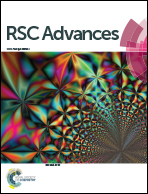Block copolymer as a novel functional phase in an aqueous biphasic system for species selective iodine extraction†
Abstract
This article describes a newly designed block copolymer based aqueous biphasic system (ABS, composed of two immiscible aqueous phases) which is further utilized to study extraction behavior of three iodine species viz., I2, I−, and IO4−. Phase diagram and tie line data reveals the potential working range of this new biphasic system. Fluorescence, dynamic light scattering, transmission electron microscopy (TEM) and conductance data establish the micellar arrangement in solutions of this particular block copolymer. Elemental iodine is easily soluble in copolymer solution due to charge transfer complexation. Polymer phase of the ABS is found to have species dependent selectivity of extraction for the three different iodine species. Two non toxic, non flammable dyes 3,6-diamino-10-phenylphenazinium chloride (DPC) and haematoxylin are introduced for the first time to detect iodide and periodate species respectively in the copolymer medium.


 Please wait while we load your content...
Please wait while we load your content...